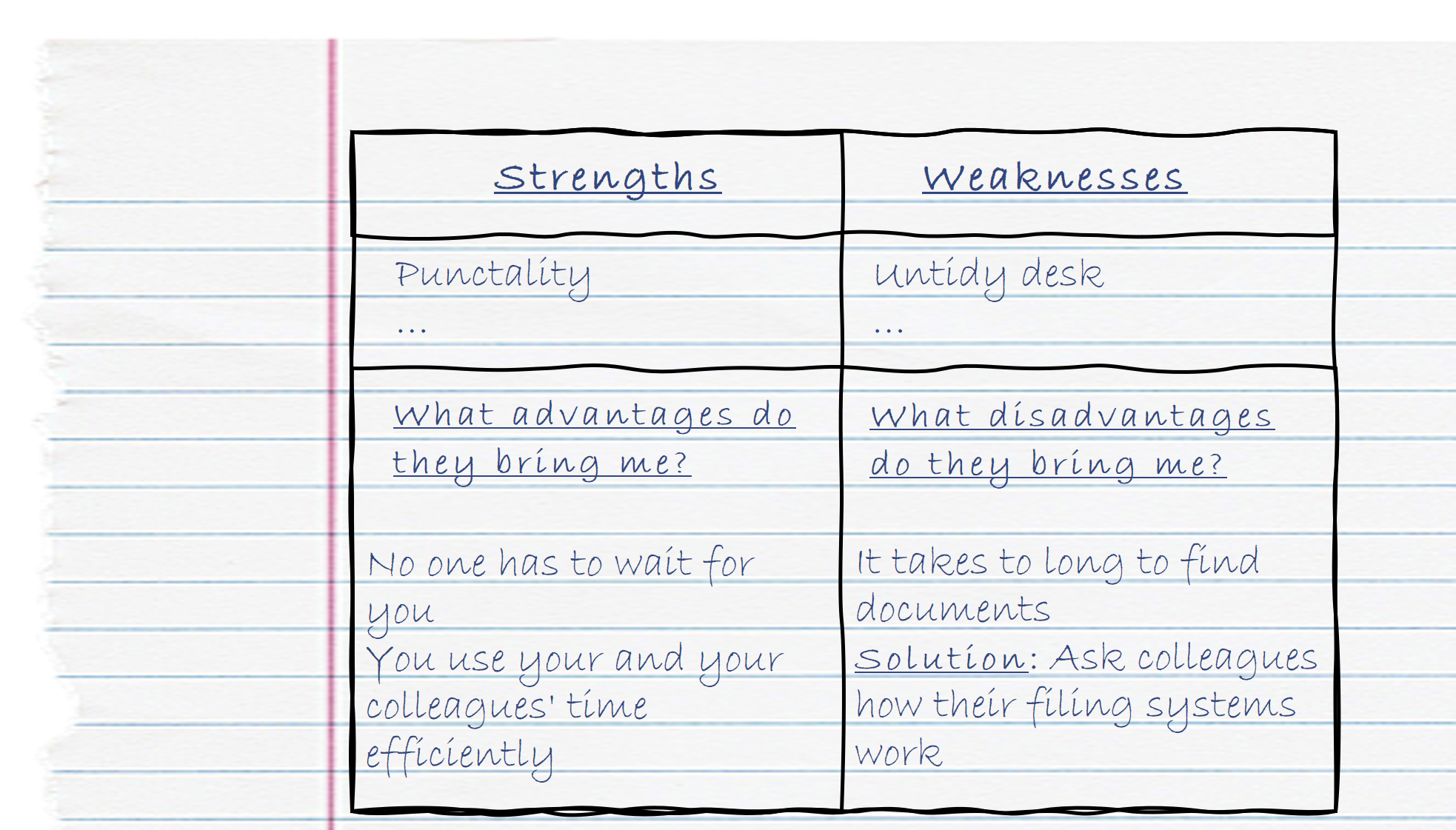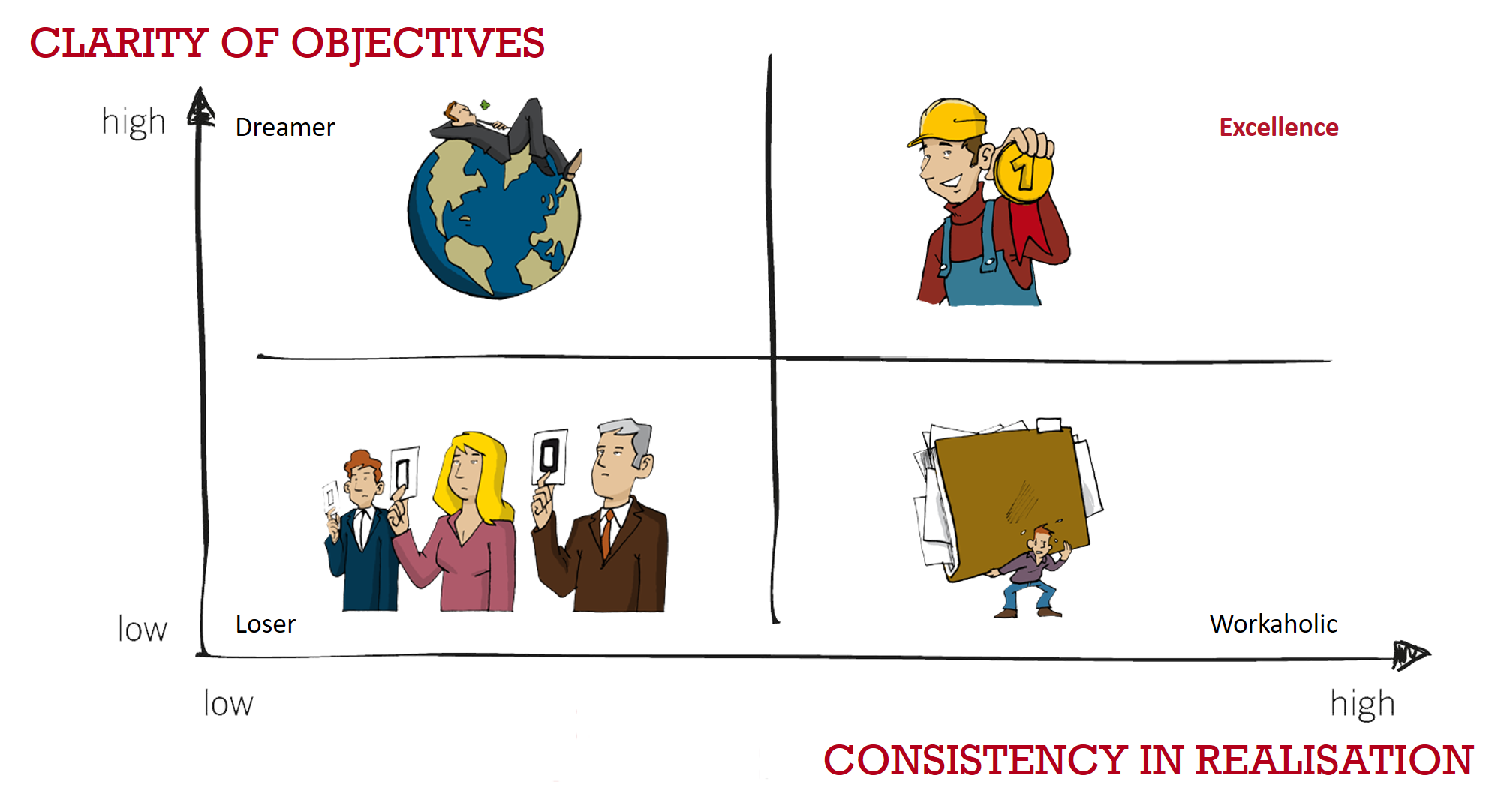Chapter 20 - Softskills¶
7. Personal Success¶
Analysis of strengths and weaknesses¶
You can only improve your abilities, if you are aware of you weaknesses. If you know you can do some things well, you won't mind discovering that you also have deficiencies. A good method of identifying deficits and skills is a strengths and weaknesses analysis. For this, you need a piece of paper, a pen and a good dose of honesty. A matrix is suitable for this purpose:

As soon as you've found out where your weaknesses are located you can work on them or use them as a strength. Only if you know both your strengths and weaknesses, you'll know how to handle and benefit from them - either by improving or by using those abilities.
Management of personal resources¶
A project manager has both tangible and intangible personal resources. Tangible - or material - resources include:
- Physical constitution
- Social environment
- Physical fitness
- Tools and assets (e.g. money, home, clothing)
The above resources are listed in reverse order of the extent to which they can be changed. You have least influence over your physical constitution, greater influence over your social environment and physical fitness and the most influence over your tools and assets. Intangible - or immaterial - resources include:
- Time
- Personality
- Disposition (the way in which a person presents himself, appearance, stance)
- Social competence
- Methodical competence
- Professional competence
You can also influence these factors to varying degrees. You have least influence over time because it cannot be manipulated (e.g. stopped or turned back). You can only use the time you have to the best possible advantage by managing it efficiently. In general, people are born with the personality they have. However, they can work on their disposition and indeed change it. Social competence, on the other hand, can be continually improved - and the best results will be achieved with the assistance of an expert. Compensating for a lack of professional competence should not be a problem, provided that the person in question is willing to make the effort.
Targets for personal success¶

As mentioned above identifying personal strengths and weaknesses is the basis for personal success. After the identification process of these, you need to overcome your own limits in order to succeed. Afterwards you only need to keep in mind, that success is feasible for everybody - there are only two questions left to consider:
- What are my goals?
- How can I realise them consistently?
The more detailed your goals are formulated and the more consistently you realise them, the higher is your personal success:

The principle of the Stoa¶
As a project manager you have to be aware of your perception of different situations in order to pick the right tools from the project management toolbox and use them in conjunction. And sometimes philosophical insights can also be useful for you. In this way some philosophical inspirations from the Stoa can help you. The lived Stoic principles (Stoics were Lucius Seneca the Younger, Epictetus, Marcus Aurelius, among others) can help to form a new kind of leadership in the project and thus contribute to personal success.
Guiding principle 1: Dedicated use - the skilful use of things
- Recognize the things which are in your power
- Perceive things which are not in your power
- Power to exert your perception about things
- Concentrate your own power on formable
Guiding principle 2: Controlled external perception towards people - good relations with people
- Differentiate between critical suggestions and offences
- Be open to critical suggestions and ideas from other people
- Redirect offences and attacks and deliberately lead discussions
- Create a climate of trust and openness
Guiding principle 3: Superior self-efficiency - dealing with yourself appropriately
- Search for the reasons of success and failure in yourself
- Become self sufficient in your judgments
- Focus on the overall task
- Get involved
Summary¶
To summarise the keywords of that chapter, here is a quick overview:
| Technical term | Definition |
|---|---|
| Personal success | Achievement of goals that you have set for yourself As soon as these goals are achieved, a feeling of success appears |
| Self-assessment | = Analysis of one's strengths and weaknesses Improve your weaknesses and use your strengths as a result |
| Volition | Conscious achievement of self-imposed goals |
| Personal resources | Tangible personal resources: Intangible personal resources: |
| Targets of personal success | Consider two questions: |
| Three principals of the Stoa | Guiding principle 1: Dedicated use - the skilful use of things Guiding principle 2: Controlled external perception towards people - good relations with people Guiding principle 3: Superior self-efficiency - dealing with yourself appropriately |
Test yourself!¶
Now it is time to check your knowledge.
Answer the following questions for yourself. Please take your time and think carefully about what you would answer before revealing the solution.
Which of the project manager's resources should be used for self-organisation?
Material resources
- Physical constitution (little scope for change)
- Social environment
- Physical fitness
- Tools and equipment (high scope for change)
Intangible resources
- Time
- Personality
- Disposition, appearance, stance
- Social competence
- Methodical competence
- Professional competence
Which are the three principles of the Stoa?
- Guiding principle 1: Dedicated use - the skilful use of things
- Guiding principle 2: Controlled external perception towards people - good relations with people
- Guiding principle 3: Superior self-efficiency - dealing with yourself appropriately